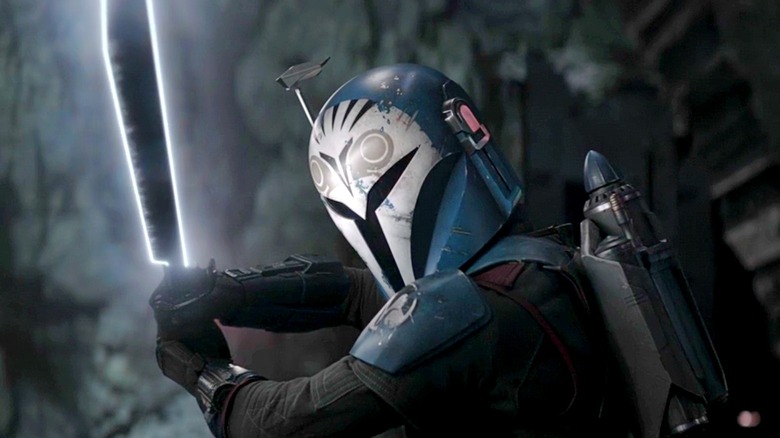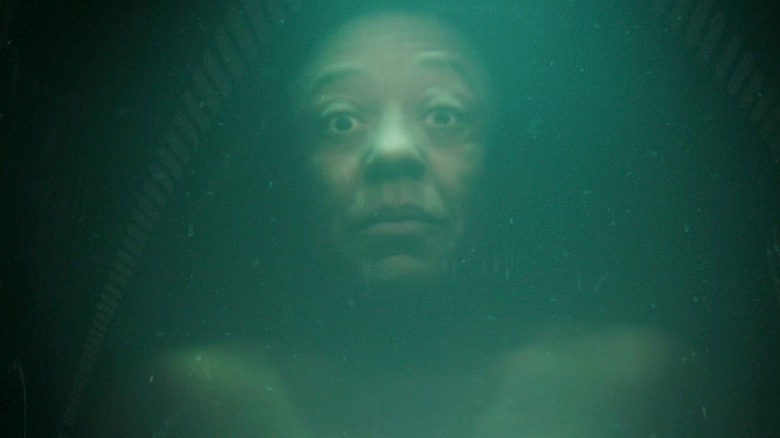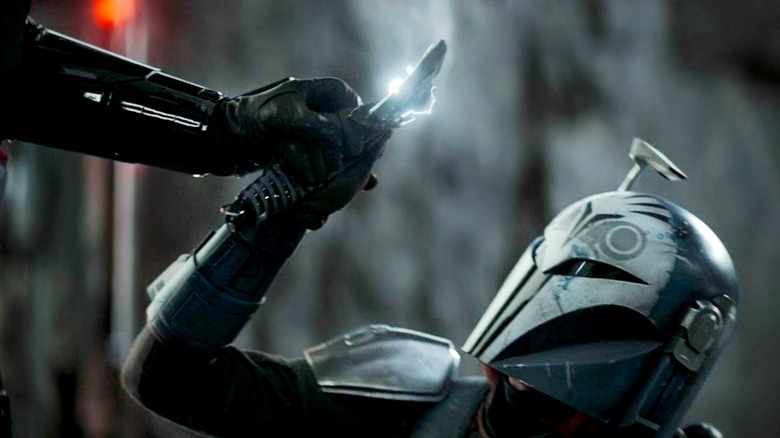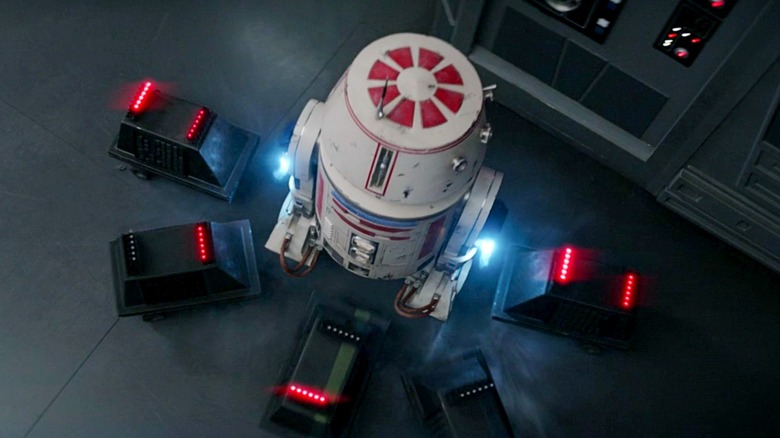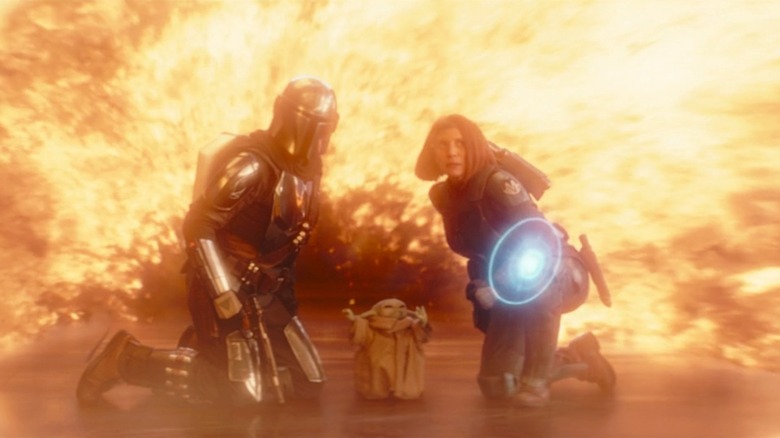The Mandalorian Season 3 Finale Ties Up Loose Ends And Sets Up The Future
There will be spoilers for "Star Wars: The Mandalorian" Chapter 24 – The Return.
The third season finale of "The Mandalorian" ends by tying up so many of the loose threads of the last three seasons, but also brings a new status quo, with a few unanswered questions remaining for future seasons.
The penultimate episode concluded with things looking grim for the Mandalorians who had come back to their home planet to take it back from the Imperials — led by the sinister Moff Gideon (Giancarlo Esposito) — who had been squatting there. Unfortunately, they walked right into a trap and were forced to sacrifice Paz Vizsla. Din Djarin (Pedro Pascal, et al) was captured and Lady Bo-Katan Kryze (Bo-Katan) was on the run, but there was still a glimmer of hope as Axe Woves (Simon Kassianides) was on his way to get reinforcements.
Not missing a beat, this episode followed each of those story threads to its logical conclusion. Bo-Katan and her cadre of warriors trapped on the planet find safety in a secret, covert farm just beneath the surface of Mandalore until reinforcements arrived. Axe Woves made it to through the cloud cover to rally the Mandalorians in the air to support Bo-Katan in attacking Moff Gideon's base. Meanwhile, Din Djarin — with the help of Grogu — manages to escape his captivity and the two of them are led by R5-D4 to Moff Gideon's command center to have a final showdown with him.
On the way to that confrontation, Grogu and Din Djarin discover that the mysterious cloning tubes are full of Moff Gideon clones. Knowing they would be a threat, Din Djarin destroys the clones, angering Moff Gideon as they begin their fight. Din Djarin is no match for Moff Gideon and his Praetorian Guards, but Grogu arrives to help. And so does Bo-Katan.
As Grogu and Mando take out the Praetorians, Bo-Katan faces her nemesis.
In the sky, Axe Woves aims the crashing Mandalorian cruiser right at the base.
Mandalorians and Imperials flee the crashing ship, Din Djarin and Bo-Katan huddle together as Grogu uses the Force to protect them from the explosion, and Moff Gideon is consumed by fire. Mandalore is once again free and the Imperial Remnant has been thwarted.
Din Djarin officially adopts Grogu and, as Bo-Katan and the Armorer work together to remake Mandalore, the pair of them put down roots on Nevarro, aiming to go on adventures to train Grogu in the ways of Mandalorians.
Force-sensitive clones
Moff Gideon's grand plan was finally revealed in full in this episode, showing that he wanted a cloned army of Force-sensitive warriors with which to rule the galaxy. The biggest revelation was that these clones were clones of him. Force-sensitive clones were a great difficulty to the Kaminoans, and this research really feels like it started on Kamino and through the work of Dr. Royce Hemlock, which is what we're seeing play out currently on the underrated animated show "Star Wars: The Bad Batch."
We know where this is all heading, though. Snoke and Palpatine are the ultimate culminations of this technology, but it could also have a lot of ramifications for the future of storytelling in the universe of "The Mandalorian" and its timeline.
Force-sensitive clones figure prominently in the story of Grand Admiral Thrawn and the original, now-Legends books starting with "Heir to the Empire." A crazed Jedi clone, Joruus C'Baoth is a tool Thrawn wields against the heroes, and there's even a clone of Luke Skywalker who gets an extra "u" in his name, too, making him Luuke Skywalker. With Thrawn the name on the tip of everyone's tongue and him making his return known in the "Ahsoka" series, this storyline is likely vital to understanding what's going to come next on that show, which is interconnected both on the timeline and thematically to "The Mandalorian."
The fate of the Darksaber
One of the more shocking twists this episode came as Moff Gideon, in his enhanced Death Trooper suit, crushed the Darksaber into oblivion. This is a weapon that has been revered by the Mandalorian people for more than a thousand years and held up as a sign of their leadership.
What will happen to Bo-Katan's endeavor to unite Mandalore without it now? When Moff Gideon took it from her the first time, it ruined her ability to bring Mandalore back together. Was his breaking it a sign that he wanted to keep them divided?
What Moff Gideon failed to understand, though, is that this new, more united Mandalore is stronger than ever and Bo-Katan even says it as Din Djarin and Grogu arrive to help her defeat Gideon. Will the Darksaber matter going forward? Or is its destruction a clever bit of symbolism that will end the infighting and challenged duels for leadership that have plagued Mandalore for generations?
Only time will tell.
Details to watch out for
There are quite a few little hints and nods to previous "Star Wars" installments in this episode. Some of it is very self-referential back to other, earlier episodes of "The Mandalorian." One of my favorites came in the form of the bacta spray from Grogu. Assuming that Din Djarin was hurt and needed medical aid, badly, Grogu kept spraying bacta in his face. If you remember back to season one, this was how IG-11 saved Din Djarin in the finale story.
Another nod: R5-D4's booster jets and place in the story. R2-D2 set the mold in helpful astromechs in "Star Wars" storytelling, and his jump-jets were introduced in "Attack of the Clones." Giving R5-D4 these jump-jets while giving him the classic R2 role was a nod to these moments. In "Revenge of the Sith," R2 is capable of taking down a group of Super Battle Droids with his jump-jets and wits, but R5-D4 is foiled here by a cadre of Mouse Droids, sirens blaring. It's fitting for such a scaredy-cat droid and shows how much attention the filmmakers pay to the tenor of each droid's character and what they can handle. R2-D2 will take down a squad of Super Battle Droids, Chopper will straight up murder other droids and drop them out of an airlock, and R5 will just get scared away by Mouse Droids making lots of noise.
Din Djarin dual-wielding pistols like Jango Fett felt like another visual nod to "Attack of the Clones," which I think might be the most underrated "Star Wars" movie.
A detail I found interesting in this episode was bringing Mandalorians back to their farming roots. This was territory that author Karen Traviss tread in her treatments of a united, post-purge Mandalore in the "Legacy of the Force" series of books. Those books are now Legends, but might give hints to what we can expect with the future of Mandalore itself.
Another flourish that calls back to classic cinema is the final shot itself. As Din Djarin and Din Grogu, Mandalorian master and apprentice, take to their pastoral digs on Nevarro, the camera irises out to black. This has long been a technique used in "Star Wars," indeed, it's how George Lucas ended all of the theatrical movies. But this time, the iris out lingers and zooms off-center to Grogu. This feels like a nod to silent films and old cartoons, Charlie Chaplin sorts of stuff in this final moment of hope. Rick Famuyiwa, director of this episode, has made no bones about the influences that Charlie Chaplin's "The Kid" has given him in making this show, I feel like this is just one more bit of evidence of that.
What comes next?
What makes a satisfying ending? Is it a big spectacle of a fight? Is it the sacrifices that characters have to make? Is it the emotion it ultimately evokes? Is it the threads it ties up? Is it the surprises that come along the way?
I think this season finale was mostly successful on all of those scores, but looking back on the season, everything seemed to work out pretty easily for everyone involved, without a lot of the twists, turns, and surprises that made the first two seasons so thrilling. This all played out fairly by the numbers. There's nothing wrong with that, per se, but it does give one some perspective and something to think about.
For me, the most exciting idea to come out of this season of "The Mandalorian" is "What comes next?"
With Bo-Katan working to rebuild Mandalore, there are certainly interesting stories to be had there and, frankly, I'd be surprised if we don't see follow-ups on that work on "Ahsoka." Ultimately, this story is one that aims to tell us that we are better together and need to set aside our differences, but it feels so much more possible in "Star Wars" than it does in the real world. Perhaps that's why the ending felt a little thin to me. How do we do that? What truth did this story reveal about that for us to take to the real world? There are Nazis resurgent the same way Moff Gideon is bringing back the Empire, but the fundamentalists among us in the real world are egging that on, rather than agreeing that it's bad. So, maybe the ending felt more twee than it was meant to.
And what of Moff Gideon's fate? It doesn't seem final. His augmented armor could have saved him from the blast, and the caches of clones that were destroyed don't feel as though they're his only ones. Could we see more of him in the future? I feel like it's a distinct possibility.
The other major story set up is Din Djarin and Din Grogu essentially becoming Nazi Hunters for the New Republic. That's an incredibly exciting prospect for me and gets the structure of that story gets the show back to the root of what made people excited about the show in the first place: Din Djarin and a baby, having adventures in the stars.
In the end, that can only be a good thing and we'll all be excited to see what comes next.
"Star Wars: The Mandalorian" is streaming only on Disney+.
